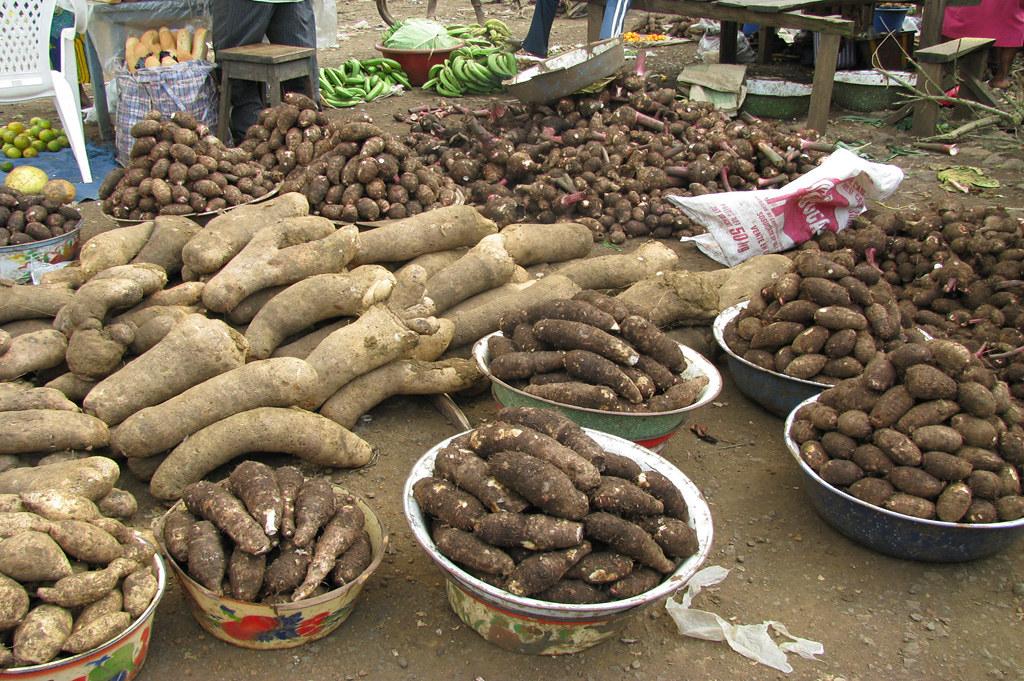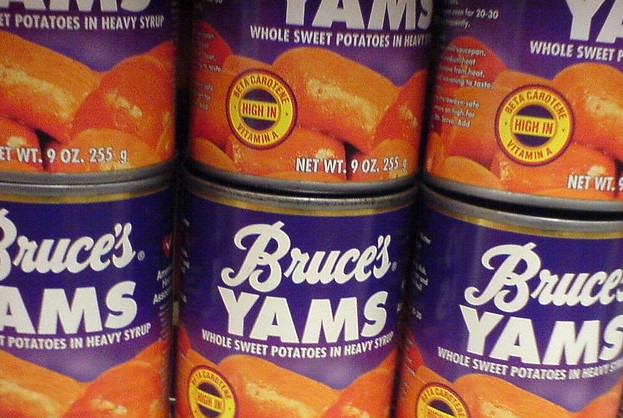As most folks in the US prepare for a Thanksgiving meal, or at least eat more Thanksgiving-inspired fall meals, potatoes and sweet potatoes often play a major supporting role in these most delicious victuals. Whether mashed, smashed, baked, candied, or turned into casseroles or pies, these starchy vegetables are stockpiled in grocery stores and markets in the fall for shoppers to turn into those tasty treats.
But sometimes there is confusion lurking in those grocery aisles and even in the minds of unwary shoppers….enter the “yam”. Wander down the canned vegetable aisle and you’ll see canned yams. Are they the same thing as sweet potatoes? And are they related to the standard potato that you usually mash, bake, or fry? I yam going to set the set the record straight.
First things first, sweet potatoes and yams are two totally different species so they are not the same thing. They’re even in different plant families so they aren’t even closely related. And neither of them are related to the regular old potato. So those “canned yams” at the grocery store are mis-named. They are sweet potatoes. Yams are rarely consumed or sold in the US, except usually though markets that sell specifically African/Caribbean foods.

Sweet potatoes are soft when cooked, thin/soft skinned, usually pretty sweet, and usually orange. Though there are some white-fleshed, less sweet varieties available. Native to tropical regions of the Americas sweet potatoes, or Ipomoea batatas, are members of the Convolvulaceae, or bindweed, family and are closely related to morning glories many of which are in the same genus Ipomoea. These sweet veggies are part of the root structure, so they are modified storage roots that store starches and sugars produced by the plant.
Yams, on the other hand, are white with a hard skin like tree bark, and are usually pretty dry when cooked. There are three main species of yams in the Dioscorea genus, which has its own family Discoreacea. Also tropical in nature, three different species were domesticated independently in Africa (D. rotundata), Asia (D. alata), and the Americas (D. trifida). Yams are monocots, meaning they are more closely related to lilies and onions than they are to sweet potatoes. Also, unlike sweet potatoes, the edible portion of a yam is a tuber, which is structure arising from modified stem tissue.

And just to round out the tater trifecta – the humble potato. Sometimes called a white potato or an Irish potato (which are both bad descriptors for them because they come in many different colors, and while they are a staple in Ireland they originate from the Americas), these versatile spuds, Solaunum tuberosum, are members of the Solanaceae family and are closely related to tomatoes, Solanum lycopersicum. Their morphology has similarities to those of the yam, though, as they are tubers arising from the stem vs being a root like sweet potatoes.
So where does all the confusion come from?
There are various theories on how yams and sweet potatoes got caught up in this mash-up, and I don’t pretend to be an expert here. But the most common theory that I’ve seen is that enslaved African people held in the US south called the local sweet potatoes by the names they used for yams, as the sweet potatoes reminded them of the yam that was part of the staple diet in many African countries. The word yam is derived from nyam, nyami, or nyambi, meaning “to taste” or “to eat” in certain African language dialects. Adding to the story, apparently Louisiana sweet potato growers in the 1930s used “yams” as a marketing name for a new orange-fleshed sweet potato cultivar and the name stuck.
One thing I find interesting is that yam was used to describe orange sweet potatoes when the white fleshed ones (which are less common now) would probably more resemble an actual yam, both in appearance and flavor. In fact, in my travels in Rwanda I ate many white fleshed sweet potatoes, as they are now a major staple crop in many African countries. It is also interesting to note that the refugee farmers in our urban farm programs prefer to grow the starchier, less sweet varieties of sweet potatoes, which often complicates things as they can be hard (and expensive) to find.
Whether you cook sweet potatoes or “white” potatoes for your Thanksgiving feast, now you’ll know a little bit about how each of those crops are different…and you’ll at least know that sweet potatoes aren’t yams.

Thanks for clearing that up! Very cool to know that sweet potato is an Ipomeia, too; might a stray sweet potato volunteer ever cross with a bindweed?
Probably not, since they are different species. But you never know….life finds a way.
Could you clarify morphological differences between a root tuber and a stem tuber?
Stems have axial buds where new stems/leaves/flowers can arise (depending on whether the stem is above or below ground). Roots do not have these structures.
It is in USA that people confuse the sweet potato for yam. The rest of the world does not. They also play football with their hands. Thirdly, Labour Day is Ist of May oor each year in the world. In the USA, it is September 1st. Ironically, Labour Day started in the United States of America.
Thank you. It’s as clear as mud….uh-oh…now we have to define what KIND of mud….gad. Actually, by the time I read through this excellent article three times, I think I got it. Thanks, again.
Thank you I always wanted to know the difference. When looking up the difference I was even more confused. This article was clear, concise and enlightening.
It’s an inaccurate and harmless distinction for shoppers. People have called them yams or candied yams for centuries here in the south. If the named would change to reflect botanic accuracy it would create unnecessary marketplace confusion.
Harmless for shoppers, yes. But I think clarity is helpful, especially for immigrants coming to the US who may find the label confusing. Also, borrowing of the term yam has a hint of cultural appropriation to it. I don’t think it an offence large enough to “cancel” yams, especially since it is common usage. But having respect for the foods of other cultures/countries and not treating them as a “brand” for something else would be more appropriate.
When we lived in Rwanda in the late 90s, white sweet potatoes were a staple food. When we lived there again after 2011, they seemed much less common (we were in Kigali both times) and were rapidly being edged out by white “Irish” potatoes, which the government was promoting to farmers.
Before that, in Togo, in West Africa, I learned that African yams are “yaahms,” with the a like in palm or “ah ha”; American yams (really sweet potatoes) are “yaams,” with the a like in “Sam I am.”
I ate a lot of white sweet potatoes when I was in Rwanda in 2019. I remember a few white Irish potatoes, but white sweet potatoes were the norm. It could possibly be a seasonal thing, since both store OK, but not year round. We visited a remote village and since they knew we were agriculturalists they were very interested to know if we knew of a way to preserve sweet potatoes year round. The Sudanese refugees that I’ve worked with in the past have also been very interested in growing white sweet potatoes. I had to special order some slips for them, and they weren’t cheap.
Great piece…I always thought of yams as the “not sweet” sweet potatoes and prefer them as sweet potatoes are too sweet for me and people tend to dump even more sweet things on them…ugh. They were the same colour, maybe a bit more pale flesh and coarser skins. This was in the deep south, so guessing they were all Ipomoea. Given the array of veggie types you can find under the same species names, that is not surprising, I guess. I remember being so astonished to learn that Queen Anne’s Lace is the same genus and species as the edible carrot…but would not advise trying to eat the former unless you are very good at plant ID because it has some very poisonous lookalikes, and there is a huge difference between “edibility” and “palatability”. Stick with the carrots.